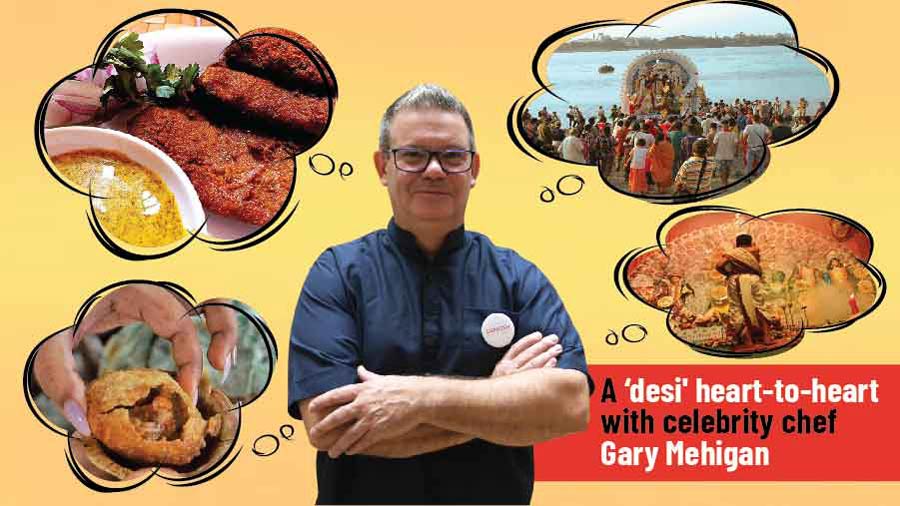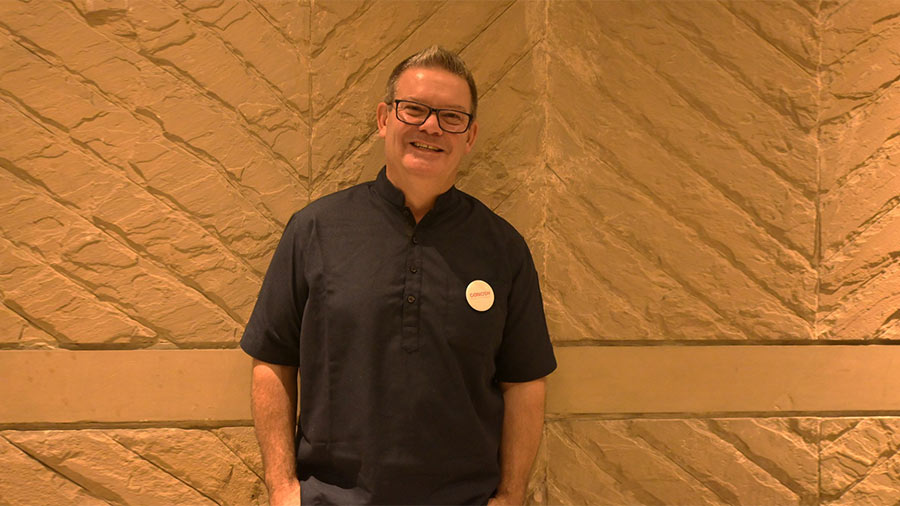National Geographic’s India's Mega Festivals episode on Durga Puja, which aired on October 11, touched upon several aspects of Bengal’s biggest festival. Taking the world through a colourful journey of Indian festivals, host and celebrated chef Gary Mehigan immersed himself in the desiness of every celebration. My Kolkata engaged in a conversation with Gary to experience Durga Puja through his eyes. Edited excerpts from the conversation…
My Kolkata: What aspect of Durga Puja did you find the most engaging?
Gary Mehigan: It is fascinating to see people coming together in extravagant celebrations and worshipping the goddess Durga. I love the emotions and thoughts behind the festival — walking from one pandal to another and witnessing immersion at sunset. It is not just Durga Puja, if you see Holi or Onam, all festivals bring people together. Holi is madness and full of colours and people enjoy it together. It is incredible how diverse the country is, but is united by festivals.

‘The scale of celebration in Kolkata from an outsider’s perspective is almost incomprehensible’
Do you think Durga Puja stands out as a festival more than others?
We filmed Onam first for the series and then Durga Puja. And for me, as an outsider, my understanding changed as I filmed all of these festivals. And the scale of celebration in Kolkata from an outsider’s perspective is almost incomprehensible. I remember hearing some numbers being thrown around — whether they’re correct or not you’ll have to check — but I heard the population of Kolkata swells by millions as people travel to the city. So, if the population is 20 million, it goes up by another 8 million as people return for Durga Puja from various parts of the world and the country. Even on the plane, I met some people coming home for the festival. They were excited and that excitement is quite moving! I haven’t seen that anywhere else.
Also, the queue outside the pandals is something that surprised me. We were shooting at this pandal that was a replica of the St. Peter’s Basilica (by Sreebhumi Sporting Club) and we got easy access. But people were queueing up for 4-5 hours just to get inside and see the artwork and the goddess. And they were inside not even for a minute. But the joy and the emotions on their faces were unimaginable. If someone told me I had to stand for five hours to get inside, I would say ‘no way!’ I also remember meeting a few American tourists in the hotel lift. I said, “Wow! You look exhausted,” and they described that they had never seen anything like this in their lives! So it’s quite remarkable and quite unique.

The Durga Puja pandal designed as St Peter’s Basilica at Sreebhumi Sporting Club
Have you tried the puja bhog? And any other food that you have tried during Durga Puja?
I have, and loved how it is a part of the festival portraying generosity. I am trying to remember what all we ate since we had a whirlwind journey. But a part of my memory about Kolkata food is always about the sweet trail. I remember the lovely sandesh and mishti doi that are also a part of the extravagant celebration. Then, the beautiful flavour of mustard oil that I keep talking about in Bhapa Ilish, Bekti fry and prawn curries. It has left a deep impression on my mind.

‘I loved how it (‘bhog’) is a part of the festival portraying generosity’
How was the experience learning dhunuchi naach? How long did it take you to pick it up?
I am an enthusiastic yet clumsy dancer. I think I made the ladies laugh a lot. But I tried hard and my enthusiasm always shines through making people smile. I really enjoyed my time with the dancers. There was this earthenware that had this incense, and they were very specific with the movements… how they wanted me to turn. It was fun and I felt like I was invited into their family. I always walk away making new friends.
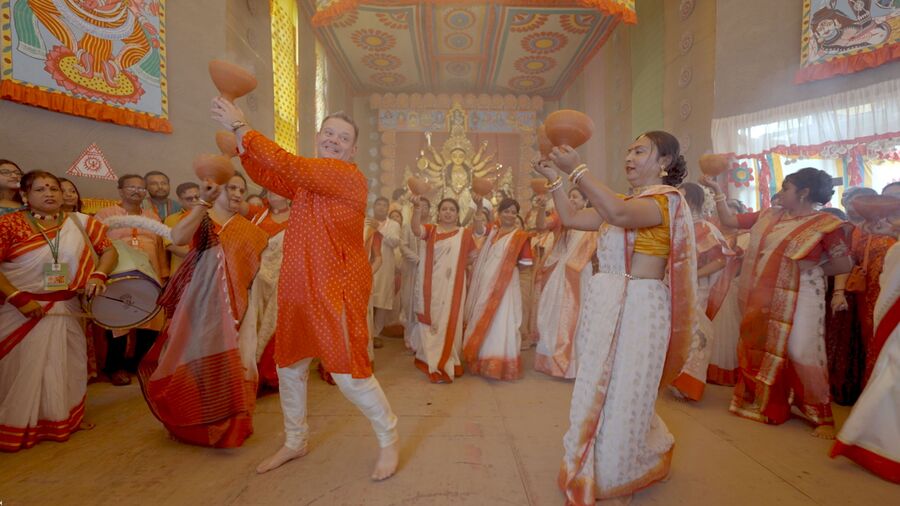
‘I am an enthusiastic yet clumsy dancer. I think I made the ladies laugh a lot’
You wore ethnic clothes on and off while filming for Mega Festivals — how was that experience? Was it comfortable?
We first went to shop for the clothes that were an integral part of visual storytelling. What Nat Geo usually does… tell stories through colour and visuals. So, we went shopping for clothes in Kolkata first and you see me wearing a lot of vibrant colours. I usually wear monochromes, but here I was conscious and kept on asking if I was looking culturally appropriate. I asked if I was looking silly but people said, “You look spectacular.” So, we have put a lot of effort into picking patterns and colours for the clothes. People have appreciated it and liked seeing me in Indian clothes, because they were so special to them.
If you could invite any historical or fictional character to join Durga Puja celebrations, who would it be and why?
It is a unique question. I don’t think anyone has ever asked me that! (laughs). But I would love to choose a mythical character like King Mahabali. It would be interesting to see India with him. I am quite intrigued by the story of the king.
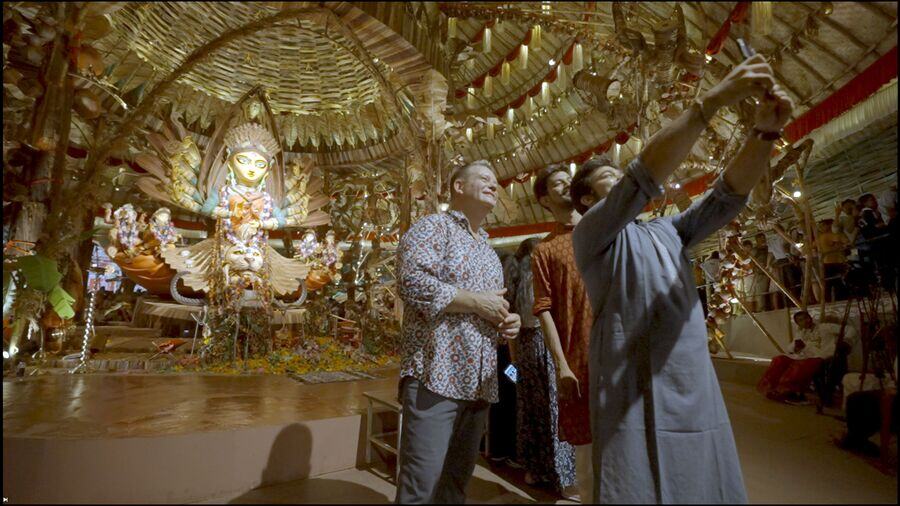
‘I loved how the Chetla pandal used sustainable materials and reused so many things to create this wonderful piece of art’
Durga Puja is known for its elaborate decorations and idols. If you were to design your own Durga Puja pandal, what theme would you choose?
I was very fascinated by the pandal made of banana plants. I loved how the Chetla pandal used sustainable materials and reused so many things to create this wonderful piece of art. So, if I have to make something, it wouldn’t be something very showy just to attract people. It has to tell a story. And with me being a chef, it would be a characterisation of the culinary world. Or it can be based on the theme of generosity. Something that sends out a message of peace and harmony. Like the Chetla pandal, it will be organic.
Tell us about the thread of feminine empowerment through the episode?
The commentary for the Durga Puja episode was about female empowerment and the nurturing side of the feminine force. We narrated the festival from a number of different avenues. For example, we were at a New Town pandal, where I tried to dance with the dhunuchi, there were female dhakis. And dhakis are mostly men, I was told. Then, I interacted with the families and found out how women from young girls to grandmothers play an integral role. I also experienced the immersion of the idol at the ghat. There, I witnessed the reverence and devotion of the people. Just that sense of community and family… is very female. So, you know you can feel that all the way through the festival.
Sweets, or mishti, are a big part of Durga Puja. Tell us about your visit to the Balaram Mullick factory in Kolkata.
It was fantastic and funny! Like you have a favourite coffee shop, people in Kolkata have their favourite sweet shop. So, if you ask, they have 10 different answers. Last time I had a lot of different sweets and I was surprised at the sheer variety. It was like how you go see wine-making. There were different flavours and textures. I love milk sandesh, but this time I liked the soan papdi. From a chef’s perspective, it is made with a lot of effort and with simple ingredients and it is absolutely delicious!
Durga’s trident symbolises her power to destroy evil. If you could eliminate one culinary misconception or stereotype from the world, what would it be, and why?
That is an interesting question and there is no simple answer. If I look at Indian food, I think people bundle Indian cuisine into one homogeneous cuisine. But it changes as you travel from region to region. So if you see the cuisine in Nagaland – it is very different. They use a lot of fermented stuff, chillies and insects too. The same fermentation is used in south India to make all these idlis and appams, but the flavours are so different with the use of coconut, curry leaves and other ingredients. So, both are different. Indian cuisine is diverse and the culinary history is more than 5,000 years old. So, I would love to end this misconception of putting all Indian cuisine in one particular bracket. It changes from home to home.
When are you back in Kolkata? What would you want to explore?
I am not coming this year as I will be travelling with Matt and George to Bengaluru, Delhi and Mumbai. I will probably come next year.
From my last visit, I made quite a few new friends and contacts and I have a whole list of restaurants and cafes and sweet shops that I have never visited before. But I will look forward to more of a grassroot experience in Kolkata next time.
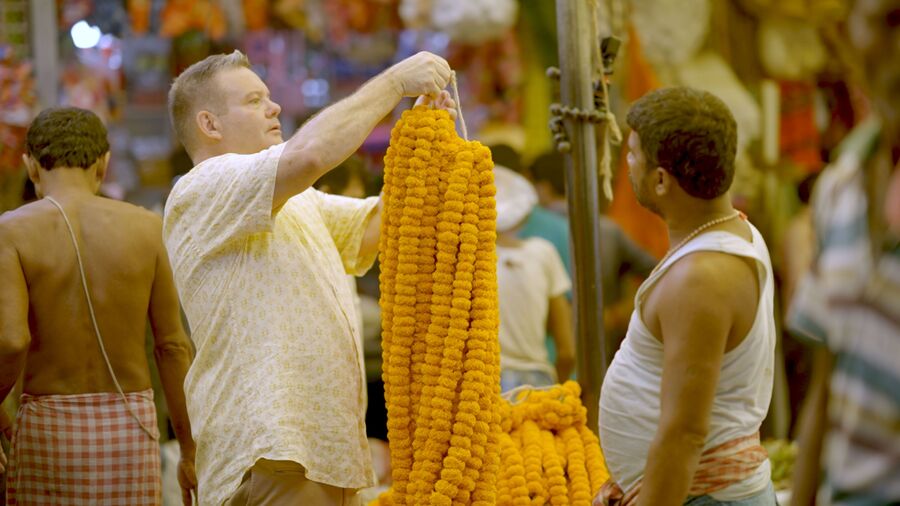
‘I will look forward to more of a grassroot experience in Kolkata’

